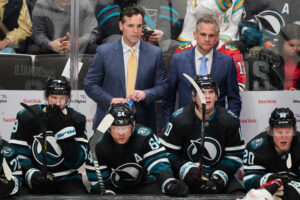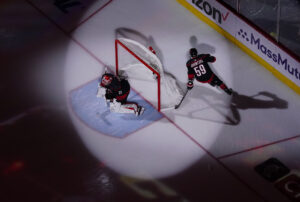A recent debate has been sparked among Buffalo Sabres fans, asking whether Casey Mittelstadt is failing because of the team around him or if it’s simply a lack of ability. Seeing how Buffalo’s poor management, coaching, and luck has drowned many players in the past years, many fans have opted towards the former side. But digging deeper, it seems the argument for the latter is plenty stronger.
This is exactly what Chad DeDominicis did in one of his recent works, using the NHLe models to explain how Mittelstadt has been on a constant decline since his draft day. But this doesn’t seal the debate that’s formed in Buffalo. Luckily, the NHLe model also opens the door to a much deeper dig into Mittelstadt’s draft position, ultimately answering whether Mittelstadt is a product of Buffalo or if Buffalo, for once, isn’t the issue.
Casey Mittelstadt Was Never Meant to Be
NHLe Models
To create this argument in as objectively as a manner as possible, it’s best to use NHLe models. These models are crafted to try and put a player’s draft year performances into perspective. They also use various methods to help create the expectations around the player’s draft year (DY), translating their performances to an NHL-point-scale in the year prior to their draft year and the few years following it.
Last Word’s Chace McCallum best describes NHLe, saying: “The general idea is simple, how much is a point in any league worth compared to a point in the NHL. It can also be called a league’s ‘translation factor’ because it roughly translates scoring in any given league to NHL scoring… A constant challenge for scouts is adjusting for the quality of various leagues… With NHLe, those scouts can get a reasonable comparison of two prospects scoring rates, no matter what leagues they play in.”
Setting the Stage
McCallum has, actually, already done an article using NHLe to show the flaws in the Sabres drafting. Through the six years that McCallum looked at, the Sabres drafting was poor, to say the least. When comparing against the NHLe model, very few of the Sabres’ choices seemed right-minded, to begin with. While comparing a person to a statistical model is obviously a bit uneven, it serves to show the team’s poor draft record.
Casey Mittelstadt’s NHLe

This figure shows Mittelstadt’s NHLe model and comes courtesy of the tremendous Byron Bader, who runs HockeyProspecting.com. Thanks to Bader and Hockey Prospecting for their help with this piece.
Draft Year
Casey Mittelstadt is no deviation from the precedent of bad draft luck that the Sabres have set. He was drafted eighth overall in the 2017 NHL Entry Draft. This didn’t seem like much of a surprise at the time. In fact, some thought it was a steal. Mittelstadt was ranked third among North American skaters in the Central Scouting Services final rankings and ranked fourth in Ben Kerr’s final rankings.
But the NHLe model heavily disagrees with Mittelstadt’s selection. In fact, Mittelstadt ranked 63rd among his draft class in DY NHLer Probability, with only 46 percent. His draft year performance, and thus his ultimate expected value, ranked closest to five players since 1990. In order from most to least they are:
William Karlsson (Drafted 53rd Overall)
Joel Eriksson Ek (Drafted 20th Overall)
Joakim Andersson (Drafted 88th Overall)
Harold Druken (Drafted 36th Overall)
Jeff Carter (Drafted 11th Overall)
This is a muddled group to be apart of. Each name was drafted significantly after Mittelstadt was, with Carter being the only one even in the same ballpark. And while Karlsson has seen a resurgence with the Vegas Golden Knights, Carter is the only one on the list to have established any sort of high-end NHL career; one worthy of a first-round selection. Druken and Andersson were low-level scorers until their retirements, Karlsson was looking hopeless until his relocation, and Eriksson Ek has surrounded himself with doubt after a cold start to his career.
Mittelstadt’s DY Performance
Mittelstadt’s draft year performance went completely against his rankings. The NHLe model placed him in unwelcoming company. The player that many thought was a steal at eighth overall was actually, well, incredibly overhyped. Even his draft-year star probability, which was atrocious, was nearly half of those drafted around him. Given that everyone wants a star at eighth overall, Mittelstadt’s low star probability is bleak, to say the least.
Ultimately, Mittelstadt’s NHLe model places him among a quintet that has an average draft selection of 42nd overall. Although to be fair, McCallum’s model places Mittelstadt’s performance as more worthy of a late first-round selection. Still, it’s far below his eighth overall selection.
Since Then
Mittelstadt hasn’t done anything to help his case since he was drafted, at least in the eyes of NHLe. After being drafted, Mittelstadt went on to have a good-but-not-great freshman season at the University of Minnesota. At the end of the year, the then 19-year-old made the jump to the NHL, playing in the Sabres final six games of the 2017-18 season and recording five points.
Mittelstadt’s Rookie Season
This short burst in the NHL set the bar very high for Mittelstadt in the eyes of many Sabres fans. While he obviously wasn’t expected to keep up a nearly point-per-game pace, many thought he could slot into the team’s top-six immediately. At least, fans hoped so. Reeling in the loss of Ryan O’Reilly, the fanbase was desperate for a quick top-six replacement. Clearly, the Sabres shared these same expectations. They gave Mittelstadt top-six minutes for most of the 2018-19 season. But his performance was far, far below the pre-season expectations. Despite being in an optimal position, receiving top-six ice time and time on the power-play and penalty-kill, Mittelstadt only managed 25 points. While not a failure — and far better than some fans make it out to be — it was an underwhelming season to say the least.
Many have chalked up the poor performance to Mittelstadt simply being apart of a struggling Sabres team. Surely a top-10 pick should do better. But the NHLe model actually predicted Mittelstadt’s performance: expecting him to tally 27 points two seasons after his draft year. Mittelstadt instead scored 25 points but only played in 77 games. Adjusting for 82 games, he was on pace for… 27 points. Perfectly in line with the model’s expectations.
Overall Performance
Of course, Casey Mittelstadt did appear in 31 NHL games this season as well, before being confined to the AHL for the rest of the year. In those 31 NHL games, he scored nine points.
Accounting for his performances since being drafted, Mittelstadt’s NHLe no longer ranks among players like Carter or Karlsson. His performance, and NHLer probability, now ranks closest with, again from most to least:
Raffi Torres (Drafted Fifth Overall)
Steve Bernier (Drafted 16th Overall)
Jarret Stoll (Drafted 36th Overall)
Ryan Donato (Drafted 56th Overall)
Wayne Primeau (Drafted 17th Overall)
If the original quintet wasn’t flattering enough, this one seems to perfectly display of where the bar lies for Mittelstadt.. and it’s not very high. The player he most-closely compares to is Raffi Torres, a notorious grinder that never managed to impress anyone, save for his one mind-boggling 27-goal season.
Ultimately, Mittelstadt isn’t expected to blossom into anything close to what an eighth-overall pick should blossom into. Instead, he’s likely going to flounder into what the NHLe model used refers to as a “replacement-level producer”. While there is certainly potential for flashes of greatness, like Torres’ 27-goal season, Stoll’s few 74-point years, or even Karlsson explosive performance in Vegas; expecting Mittelstadt to become the consistent top-six forward that Buffalo so desperately needs is wishful thinking.
What This All Means
This answers the argument. Casey Mittelstadt isn’t a product of a bad situation in Buffalo. The Sabres simply got fleeced. As the NHLe model shows, Mittelstadt had no business being featured in the top-10 of the 2017 Draft rankings. Since his draft year, things have only gotten worse for Mittelstadt, elaborated perfectly by DeDominicis. A draft year performance that ranked Mittelstadt among alright players has since degraded into a grouping with some far-from-great players.
In the end, the Sabres poor draft luck peaked in 2017. They passed up players like Robert Thomas, Nick Suzuki, and Kailer Yamamoto to select a player that was supposed to be the next great American talent. Instead, Mittelstadt has floundered. He has proven that his expectations were set far, far too high. Casey Mittelstadt is not a product of the Buffalo system. He’s just not that good.
Main Photo:






